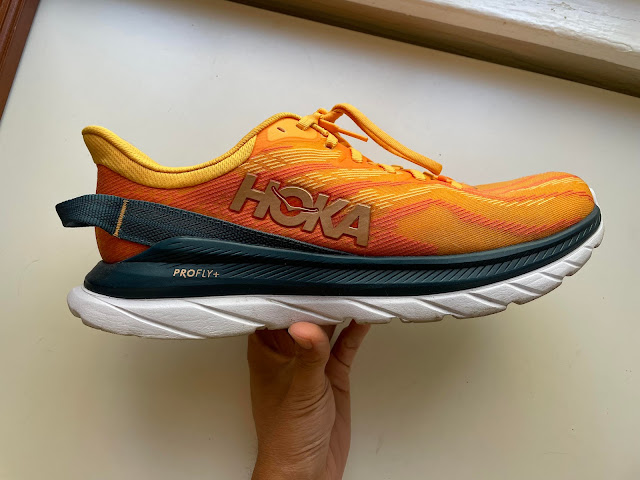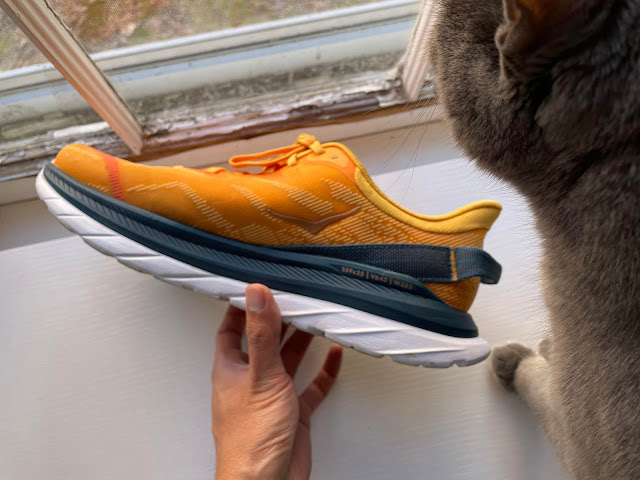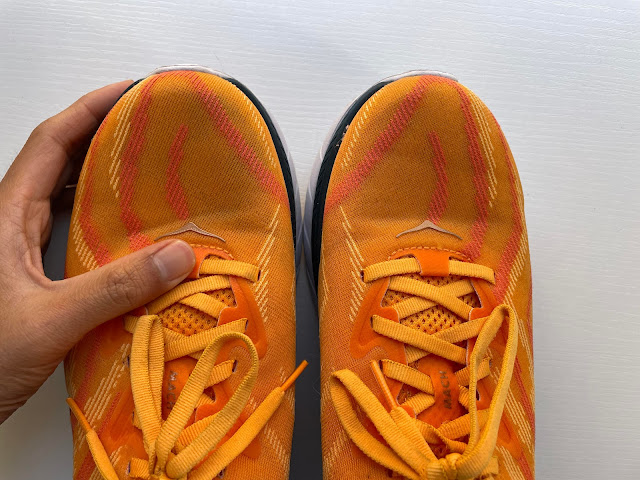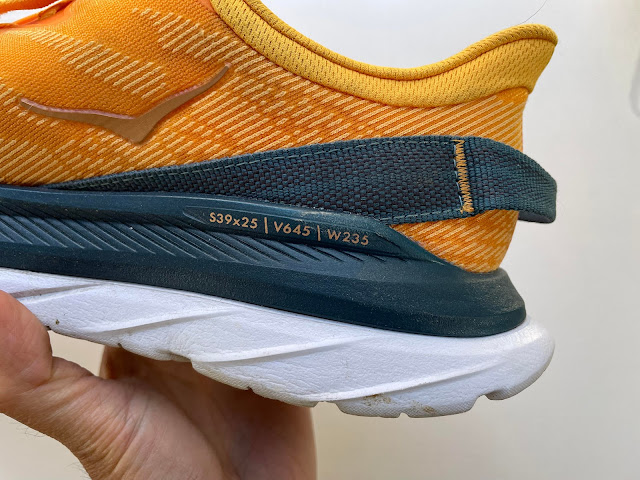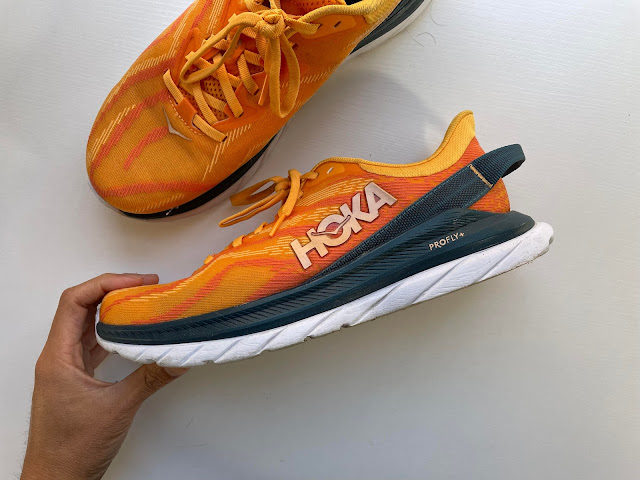Hoka Mach Supersonic Review: Is Worth the Upgrade?
By Chief Editor/Founder Matt Klein, Senior Contributor Nathan Brown, and Social Media Wizard Bach Pham
The Hoka Mach series has seen some large shifts in design over its lifespan. An odd option that almost didn't fit in the line up, the Mach 4 was a favorite among our team for its lightweight cushioning that made it more accessible as a workout/racing shoe for those who wanted softer cushioning in a faster ride that could also be used for training. The Hoka Mach Supersonic comes in as a variation of the Mach 4 using a PROFLY+ midsole foam, a new supercritical EVA and a modified upper that again changes things drastically.
Price: $149.95 at Running Warehouse
Weight: 8.3 oz, 235 g (men's size 9), 6.9 oz, 195 g (women's size 8)
Stack Height: (M) 29 mm / 24 mm (W) 27 mm / 22 mm
Drop: 5 mm
Classification: Lightweight Trainer
RUNNING SHOE SUMMARY
Matt: The
Hoka Mach Supersonic is a firmer/faster Mach for those that want a
lightweight trainer that can push the pace. A snugger upper provides a
performance fit, while a firmer midsole material makes this shoe better
for faster and shorter distances. A strong departure from the Mach 4
despite looking similar, the Mach Supersonic loses versatility at
recovery/training paces while gaining a faster edge for tempo and
interval workouts.
Nathan: The Hoka Mach Supersonic is a limited release option
for the Mach series. It brings a very different feel than the beloved
Mach 4, being significantly firmer and stiffer front to back, as well as
a more snug fit. The geometric shaping and layout of the dual layered
midsole look similar, but the shoe runs very differently.
Bach: The Mach Supersonic takes the popular platform that the Mach 4 introduced and gets reinjected with Hoka's new Profly+ midsole. The limited release shoe provides a taste of Hoka's latest midsole technology. The shoe provides fairly similar versatility as the Mach 4, but performs well at "supersonic" speeds - though at the cost of a slightly firmer sole. The shoe still, however, offers a buttery transition and stable base Hoka is known for.
FIT
Matt: The
Hoka Mach Supersonic fits me true to size in my normal men's US size
10. The fit is snug throughout the length of the shoe, especially at the
forefoot. The Mach Supersonic has a performance fit, using a
full-length jacquard upper. It feels secure on foot and I did not have
to lace lock the shoe at all. The forefoot is narrow, giving more of a
workout/racing fit. The midfoot and heel are somewhat snug, but solidly
secure. The contoured heel collar sits against the Achilles tendon well
and is not overdone, further adding to the security. There is a stiffer
heel counter in the rearfoot that wraps fairly far forward on the medial
and lateral side of the heel. There is plenty of heel collar
cushioning, although those with sensitive heels should be cautious. For
those who want it or like being able to slip a shoe on and off easily,
there is a massive pull tab (Jami is this enough?). The tongue is
slightly thicker and is secured well due to gusseting on both sides.
While the upper does stretch a little, this upper overall will work for
those who want a performance or narrower fit.
Nathan: The
new upper in this model removes a lot of volume and gives a snug
performance-like fit. The heel is secure thanks to this narrowing, and
the midfoot locks down very well. An area that I noticed the decreased
volume the most was the toe box, particularly laterally. There is not a
lot of stretch to the upper, which for lockdown is effective, but
doesn't allow for accommodation if you have a moderate to wider foot.
The more rigid upper also doesn't scream "comfort" but is geared again
towards achieving lock-down. Going back to the heel, there is moderate
padding on the rigid heel counter as well as the gusseted tongue, and
the contoured heel counter adds to the security of the heel. I found it
to be a bit snug on casual running days, but the lockdown was
appreciated for harder efforts.
Bach: The Mach Supersonic's upper fits comfortable for me despite testing a pair a half size up. The shoe has a slightly narrow fit throughout which made the half size up feel fairly comfortable for my standard feet. The shoe locks down in the heel quite well. The tongue is just a touch on the short side which makes slipping the shoe on a little awkward and once on foot feels a bit shallow, but the lacing, gusseted tongue, and sturdy heel do all work together well in providing a nice lockdown fit. Additionally, despite it being a huge pull tab visually, I felt the pull tab integration didn't really work for making it easier to put the shoe on as it is attached to the wrong parts of the shoe to make it an effective pull tab. Come on Hoka!!
PERFORMANCE
Matt: The
Hoka Mach Supersonic has a slightly firmer and snappy ride. The PROFLY+
midsole foam is resilient, but not soft. Upon break-in, the ride is
firmer and stiffer. This breaks in slightly but has continued performing
in a similar manner. There is little flexibility to this shoe, which
combined with the slightly firmer ride makes it better for uptempo and
faster paces. Running at easy paces makes this shoe feel too stiff, but
picking the pace up helps the foam shine a bit more. There is a 5mm heel
drop which is only slightly noticeable due to the heel bevel and toe
spring. The traction is average for a road shoe and the exposed rubber
makes this shoe best for road-only use. I have over 30 miles on my pair
and am chewing through the exposed outsole rubber, so the Mach
Supersonic will work better for that are light on their feet (unlike
me). The shoe overall feels light on the feet and will work best as a
lightweight trainer or workout shoe. It is easy to pick up the pace in
the Mach Supersonic and it does well during tempo runs and fast interval
workouts. Although not a plated shoe, the ride is stiff enough that it
works as a great alternative.
Nathan: The Supersonic,
though it is constructed similarly, gives a very different running
experience than the Mach 4. The Mach 4 was one of the most versatile
shoes of 2021, and it provided a combination of softer cushioning,
responsive foam, and some snappiness from the firmer EVA bottom layer.
The Supersonic loses versatility, and provides a quite firm and stiff
ride. The new supercritical PROFLY+ topsole reminds me of QU!CKFOAM from
361, and it is more of a "rubbery" pop than a trampoline like pop.
Really this just adds to how firm this shoe is, and I didn't find the
topsole to be very responsive anyway. Given how stiff and firm this shoe
is, it really only performs okay at tempo paces or strides, and felt
awkward and very firm and clunky at anything slower. This is a one-off
shoe from HOKA that doesn't plan to be continued, so you'll have to want
this firmer, more stiff (and less versatile) vibe to go the Supersonic
route.
Bach: Unlike Nathan and Matt, while it leaned firm, I didn't mind the midsole of the Mach Supersonic for daily training. As a fairly light footed runner, the shoe transitions very smoothly through the midfoot thanks to a clean bevel and mild toe spring. I was able to do everything from easy to long runs in the Supersonic. I noticed that the shoe particularly comes alive mid-run as the foam warms up and the Profly+ midsole starts to have some responsiveness. I felt it was a great shoe to quietly warm-up in then take off into a tempo run or intervals where the shoe performs best. That being said, I would not go as far as say there is anything particularly standout about the Mach Supersonic and its new Profly+ foam as far as performance. It just feels like a solidly capable trainer that can pick up the pace, while leaning on the slightly firm side. Construction-wise, the new Profly+ sits on top of traditional EVA, providing a slightly softer sole on step in and the firmer landing/take off with the EVA underneath. While I believe the Profly+ is somewhat soft, it compresses into the firmer EVA so quickly that you really just get a firmer sensation than anything. For my personal tastes, I don't find this necessarily bad, but you are not getting a soft sensation that the new Profly+ midsole promises in this setup.
The outsole grip feels fairly average, but did hold it's own. Despite a lot of exposed rubber, the shoe gripped to wet road surprisingly well and was able to handle a very wet road run confidently. The traction is not particularly exciting in terms of performance; the shoe's capabilities mainly relies on the geometry to carry the runner forward. The overall durability is fairly average, with some decent wear seen in the exposed areas. I expect 200-250 miles at most out of the Supersonic.
STABILITY
Matt: The
Hoka Mach Supersonic is a neutral shoe. However, there are a few
methods of stability here that are emphasized more than the previous
version. There continue to be elevated sidewalls in the rearfoot on the
medial and lateral side which serve to provide some subtle guidance for
rearfoot strikers. The firmer midsole is more stable than the previous
version as there is far more torsional rigidity here versus the Mach 4.
The stiff and rockered ride do a decent job of rolling the foot forward,
although during break in the ride almost feels too stiff and made me
feel like I was trying to get around the stiffer forefoot. This has
broken in and is not noticeable during workouts, but is another reason
why this shoe does better at faster paces.
Nathan: There
is a lot of traditional HOKA design here, which creates a relatively
stable, yet neutral platform. The wider base, the secure upper, side
walls, midline cutout and heel counter all give some guidance toward
center. Pair that with a firmer foam and it is a relatively stable
platform. However, as Matt mentioned, the shoe is really firm, and
transitions at slower paces are not smooth if you don't match up with
the mild rocker well, so you might find yourself fighting through
transitions.
Bach: The Supersonic is a neutral shoe with inherent stability from Hoka's basic principles of design. The shoe features a wide base throughout that makes landing either way fairly comfortable. The mild toe spring and midline cutout promotes mild guidance. The firmer sole also provides a solidly stable platform and as Matt and Nathan have indicated, work well with the toe spring to make transitions fairly smooth. I tend to have some issues with my left foot in very neutral footwear, but had no issues in the Mach Supersonic in terms of stability due to these features. Having some mismatched feet in terms of needs, Hoka design in general does a nice job of providing a stable neutral design that accommodates both neutral runners and those who need mild stability. This is still considered a neutral shoe despite all of the unique components due to its lack of an obtrusive stability features.
 |
| Insole is removable |
THOUGHTS AS A DPT / FOOTWEAR SCIENCE
Is Softer or Firmer Cushioning Better?, By Chief Editor Matt Klein
The
Hoka Mach Supersonic is noticeably firmer and stiffer compared to the
previous Mach. This not only changes the ride but a few other
characteristics of the shoe. Looking at midsoles alone, a firmer ride is
inherently more stable. A higher durometer or firmer sole will deform
less and intrinsic muscles will not have to work as hard as there is
less extraneous motion. A lower durometer or softer sole will deform
much more. That deformation is rarely in a perfectly straight plane of
motion (like the sagittal plane or front to back) and there is likely to
be extra motion in different planes of movement, including transverse
(across) and frontal (side to side) planes.
Softer cushioning is
not bad but it requires additional stability for many people.
Additionally, we know from the evidence that softer or more cushioning
does not necessarily provide more impact protection (Chan et al. 2018).
It may actually increase joint loading in certain individuals,
potentially due to decreased or delayed proprioception or body awareness
(Kulmala et al., 2018; Pollard et al., 2018). This does not occur in
everyone and some people will do better in softer shoes due to the
frequently discussed comfort filter.
However, that does not
necessarily mean firmer cushioning is better. Firmer shoes will often
have less deformation, which means more shock absorption needs to come
from the muscles/joints. This can be a great training tool for running
faster or for strengthening the lower body. However, running in firmer
shoes have some requirements. The main one is having adequate strength
in the lower body, particularly of the muscles related to shock
absorption (quadriceps/gluteal muscles for a heel striker, calf for
forefoot striker). This differs from the requirements for running in
softer shoes, which mainly are related to having adequate
stability/intrinsic muscle strength from the foot and hip to handle
being on an unstable surface.
We have frequently discussed that
the comfort filter can play a large part in predicting whether a shoe
will work for someone or not (Nigg et al., 2015). Like all subjective
things, this will vary greatly depending on the individual as comfort is
complex and multifaceted when it comes to footwear choices (Menz et
al., 2021). When it comes to softer/firmer cushioning, different people
will have different preferences. I encourage each person to try
different shoes on to find out what works best for their own bodies
given that we are all different. This can be difficult for newer
runners, who may not know what they are looking for. For those
interesting, Bishop et al. (2020) have developed an excellent running
shoe comfort assessment tool called the RUN-CAT. For newer runners,
those who work in running retail or experienced runners looking for more
information, the RUN-CAT may provide some interesting insight into
personal perceptions of footwear and may help with decisions regarding
the best shoe for that person.
References
Bishop,
C., Buckley, J. D., Esterman, A. E., & Arnold, J. B. (2020). The
running shoe comfort assessment tool (RUN-CAT): Development and
evaluation of a new multi-item assessment tool for evaluating the
comfort of running footwear. Journal of sports sciences, 38(18), 2100-2107.
Chan,
Z. Y., Au, I. P., Lau, F. O., Ching, E. C., Zhang, J. H., & Cheung,
R. T. (2018). Does maximalist footwear lower impact loading during
level ground and downhill running? European Journal of Sport Science, 18(8), 1083-1089
Kulmala,
J. P., Kosonen, J., Nurminen, J., & Avela, J. (2018). Running in
highly cushioned shoes increases leg stiffness and amplifies impact
loading. Scientific Reports, 8(1), 17496.
Mercer,
M. A., Stone, T. M., Young, J. C., & Mercer, J. A. (2018). Running
Economy While Running in Shoes Categorized as Maximal
Cushioning. International journal of exercise science, 11(2), 1031
Menz, H. B., & Bonanno, D. R. (2021). Footwear comfort: a systematic search and narrative synthesis of the literature. Journal of Foot and Ankle Research, 14(1), 1-11
Nigg,
B. M., Baltich, J., Hoerzer, S., & Enders, H. (2015). Running shoes
and running injuries: mythbusting and a proposal for two new
paradigms:‘preferred movement path’and ‘comfort filter’. British Journal of Sports Medicine, 49(20), 1290-1294
Pollard,
C. D., Ter Har, J. A., Hannigan, J. J., & Norcross, M. F. (2018).
Influence of maximal running shoes on biomechanics before and after a 5K
run. Orthopaedic Journal of Sports Medicine, 6(6), 2325967118775720
RECOMMENDATIONS
Matt: Many
of the changes in the Hoka Mach Supersonic are good. The increased
torsional rigidity makes the shoe more stable and the upper provides a
more performance fit. This pushes the Mach Supersonic toward the faster
end of the spectrum. It loses the versatile ride of the previous
version, which may or may not be a good thing. Hoka needs to decide what
their customer base wants, as most seem to want softer cushioning.
However, from a performance standpoint, the Mach Supersonic is much
better for faster running and therefore is better differentiated from
other training models. So I do not have major recommendations because
even though I liked the Mach 4, the Supersonic has a better-defined
place in the Hoka lineup. The problem is that my tastes are often
different from the general population, so I am interested to hear the
public's reaction to trying this shoe.
Nathan: Given that
this is a "one off" model, not sure how many recommendations we need to
say. Mainly, I hope that the Mach 5 is more of a natural progression of
the Mach 4 that gave a very versatile ride.
Bach: In some ways, the Supersonic takes a step back in the Mach series by going more towards a firmer, aggressive piece of footwear. In terms of a limited release shoe, I think Hoka could have considered ways of taking bigger chances to make the Supersonic standout, potentially adding even more Profly+, toying with the Kawana heel flare in this design, or something to make it standout. If a shoe is not planned to be a large wide release, I think Hoka could have considered taking more dramatic steps in design rather than put something not so dramatically different into the world. Instead, the Supersonic fits in a strange place next to the highly successful Mach 4.
In terms of where the Mach series goes from here, I would love to see a better integration of the Profly+ midsole to get a better sense of its maximum performance. If Hoka decides to focus the Mach series on being their workout trainer, I would also be interested in some light forefoot outsole to promote better traction, which may increase the grip and excitement of the forefoot.
Additionally, despite the fact that I like pull tabs, I found the horizontal pull tab to actually be quite difficult to use in putting the shoe on as it is not attached to the center of the heel counter where I need the most tension typically to pull the shoe on. The tab instead pulls at the sides which never help like it was assisting in pulling the shoe on. I think a traditional pull tab down the center of the heel or their elf ear design would be much better suited moving forward.
WHO THIS SHOE IS FOR
Matt: The
Hoka Mach Supersonic is a slightly firmer, snug fitting,
performance/lightweight trainer for those who want a shoe for uptempo
running and workouts. The stiffer ride and firmer cushioning make the
shoe more responsive during faster running, while the performance upper
makes you feel fast. This is a different shoe from the Mach 4 and those
looking for a stiffer but non-plated road workout shoe will enjoy the
new Mach Supersonic.
Nathan: The HOKA Mach Supersonic is a
good option for people wanting a tempo and workout only shoe that
operates on the firmer and stiffer end of the spectrum without having a
plate. It is also for people who do well in a snugger fit and prefer
back to front lockdown without a lot of wiggle room. If you're looking
for the versatile progression of the Mach 4, you may want to wait.
Bach: The Mach Supersonic is a limited release shoe from Hoka that provides a sample of the Profly+ midsole. The shoe is inherently stable neutral in design, featuring a slightly firmer ride that transitions well. The upper runs somewhat snug and performance-fitting. For those who have a slightly wider feet or standard feet and prefers a lot of room to splay, a half size up is recommended. For those who are light on their feet, the Supersonic offers a smooth ride for those who prefer a firmer landing, and for others who pound the pavement, this is best as an uptempo day shoe and likely not much else due to how firm it is with increased force.
GRADING
Matt
Fit: B+ (Snug performance fit. Gets a little narrow at forefoot)
Performance: B+ (Great for running fast, but less versatile at training paces)
Stability: B+ (small
sidewalls in heel provide rearfoot guidance. Forefoot almost too stiff
unless running fast, which may cause some extra motion)
DPT/Footwear Science: B (Nothing major new here other than a firmer midsole.)
Personal: B (A
solid workout shoe, but there are so many faster shoes that it is hard
to chose these over others unless you do not want something plated)
Overall: B+ (A
solid lightweight trainer for those who want a firmer/snugger shoe than
other higher stack options for workouts or uptempo running)
Nathan
Fit: B+ (Solid
performance fit, a bit too snug in forefoot. I couldn't fit my thicker
winter socks in this shoe without irritation. Good heel lock.)
Performance: C+ (Rides quite firm and stiff, not very responsive, solid option as a tempo only shoe, lacks versatility)
Stability: B+ (Classic neutral HOKA shoe with some stability increased due to firmer foam, but transitions are arduous at slower paces)
DPT/Footwear Science: B (Still appreciate the combination of top and lower midsole compounds and crash pad cutout)
Personal: C (This
shoe only does "okay" for me at faster paces, and is not enjoyable for
daily miles or recovery. I found it too firm and stiff)
Overall: B- (I
feel this is not a movement forward for the Mach series, and this model
isn't a part of HOKA's future plans. If it works for you, stock up. I
won't be doing so.)
Bach
Fit: B/B+ (A snug fit hinders the Mach Supersonic's score, making it difficult to recommend sizing. The upper when on though does provide excellent lockdown)
Performance: B/B+ (Despite a firmer sole, it still provides a genuinely smooth ride that I enjoyed. Uptempo, the shoe is decently fun. This is a shoe that will come down heavily towards preference, which I feel in today's softer society will lean more towards a B grading)
Stability: B+ [Stable Neutral] (Very stable design throughout with guidance from toe spring and midfoot cutout, a wide base, and firmer sole)
DPT/Footwear Science: B - (In terms of innovation, Hoka basically took the Mach 4 platform and swapped in some Profly+. I think there could have been more thought into really making this limited release pop, possibly using Profly+ throughout and taking more risks)
Personal: B+ (At the end of the day, this feels still like a smooth Hoka ride and for my mechanics, fit my preferences surprisingly well)
Overall: B/B+ (The shoe will be based on preference between firm vs. soft, and if you are in a snug, firmer workout shoe that can pick up decently well)
VIDEO REVIEW
Our team discusses the Hoka Mach Supersonic and Kawana further in a recent podcast!
SHOP | SUPPORT DOR
Price: $149.95 at Running Warehouse
Men | Women
*Using the link to purchase helps support Doctors of Running. Thanks so much!
Check out Gear We Love
Feetures Socks: Massively grippy socks that will make you feel more one with the shoe
Huma Chia Gel: Natural and goes down easy. Powered Contributor Nathan Brown to his marathon
Trigger Point Foam Roller: Help get those knots out post-run and feel better for tomorrow
Theragun Massager: This small version is great on the go for working tired legs
Ciele Hat: Our team's favorite running hat of choice!
FURTHER READING
Nike Structure 24 - Slightly refined update for the mild stability trainer
Saucony Axon 2 - A highly valued rockered ride at $100
Adidas SolarGlide 5 - A great update to a struggling series improves the workhorse trainer
Diadora Mythos Blushield 6 - The Italian maker's stability shoe model, with a plush underfoot
Xtep RC260 - A decently priced, plated pebax trainer from the Chinese brand
Find all Shoe Reviews at Doctors of Running here.
Thanks for reading!
FOLLOW DOCTORS OF RUNNING ON SOCIAL MEDIAFacebook: Doctors of Running
Youtube Channel: Doctors of Running
Instagram: @doctorsofrunning
Linkedin: Doctors of Running
Strava: Doctors of Running
Podcast: Virtual Roundtable
Pinterest: Doctors of Running
Editor's Note: As always, the views presented on this website belong to myself or the selected few who contribute to these posts. This website should not and does not serve as a replacement for seeking medical care. If you are currently injured or concerned about an injury, please see your local running physical therapist. If you are in the Los Angeles area, I am currently taking clients for running evaluations.
Contact us at doctorsofrunning@gmail.com
NEXT: How Should Shoes Fit?
